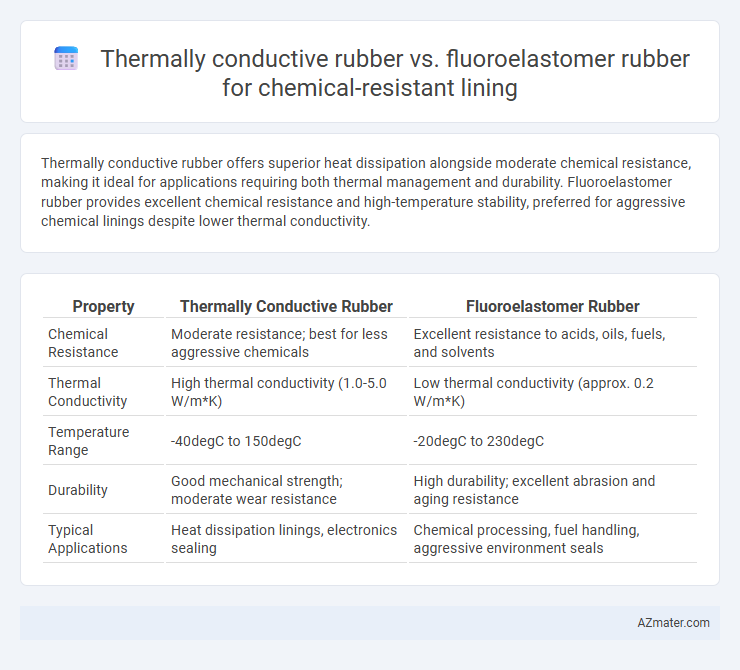Thermally conductive rubber offers superior heat dissipation alongside moderate chemical resistance, making it ideal for applications requiring both thermal management and durability. Fluoroelastomer rubber provides excellent chemical resistance and high-temperature stability, preferred for aggressive chemical linings despite lower thermal conductivity.
Table of Comparison
| Property | Thermally Conductive Rubber | Fluoroelastomer Rubber |
|---|---|---|
| Chemical Resistance | Moderate resistance; best for less aggressive chemicals | Excellent resistance to acids, oils, fuels, and solvents |
| Thermal Conductivity | High thermal conductivity (1.0-5.0 W/m*K) | Low thermal conductivity (approx. 0.2 W/m*K) |
| Temperature Range | -40degC to 150degC | -20degC to 230degC |
| Durability | Good mechanical strength; moderate wear resistance | High durability; excellent abrasion and aging resistance |
| Typical Applications | Heat dissipation linings, electronics sealing | Chemical processing, fuel handling, aggressive environment seals |
Introduction to Chemical Resistant Linings
Chemical resistant linings require materials that effectively resist aggressive chemicals while maintaining structural integrity and performance. Thermally conductive rubber provides excellent heat dissipation but may have limitations in harsh chemical environments, whereas fluoroelastomer rubber offers superior chemical resistance against acids, solvents, and fuels, making it ideal for demanding applications. Selecting between these materials depends on balancing thermal management needs with chemical durability for optimal lining longevity.
Overview of Thermally Conductive Rubber
Thermally conductive rubber is engineered to combine flexibility with efficient heat dissipation, making it ideal for applications requiring temperature regulation and chemical resistance. This material offers enhanced thermal conductivity through filler materials such as boron nitride or aluminum oxide, while maintaining excellent chemical resistance against oils, solvents, and acids. Compared to fluoroelastomer rubber, thermally conductive rubber provides superior heat transfer capabilities without compromising durability in harsh chemical environments.
Key Properties of Fluoroelastomer Rubber
Fluoroelastomer rubber exhibits exceptional chemical resistance, particularly against fuels, oils, and aggressive solvents, making it ideal for chemical resistant lining applications. Its high thermal stability, maintaining integrity at temperatures exceeding 200degC, ensures durability in harsh environments where thermal conductivity is secondary. Compared to thermally conductive rubber, fluoroelastomers offer superior resistance to swelling, degradation, and permeation by corrosive substances, providing reliable containment and protection in industrial settings.
Thermal Conductivity: A Comparative Analysis
Thermally conductive rubber exhibits significantly higher thermal conductivity, typically ranging from 1 to 10 W/m*K, enabling efficient heat dissipation in chemical-resistant linings. Fluoroelastomer rubber, with thermal conductivity values around 0.2 W/m*K, provides excellent chemical resistance but lower heat transfer capabilities. This disparity impacts application choices where balancing thermal management and chemical resistance is critical in industrial lining solutions.
Chemical Resistance: Performance Evaluation
Thermally conductive rubber exhibits moderate chemical resistance but may degrade when exposed to strong acids, bases, or organic solvents, limiting its use in aggressive chemical environments. Fluoroelastomer rubber demonstrates superior chemical resistance, with excellent stability against a broad range of chemicals including hydrocarbons, solvents, acids, and bases, making it ideal for chemical-resistant linings. Performance evaluations reveal that fluoroelastomers maintain mechanical integrity and resistance to swelling or degradation far better than thermally conductive rubbers in harsh chemical conditions.
Mechanical Strength and Durability
Thermally conductive rubber exhibits superior mechanical strength with enhanced tear resistance and elongation properties, making it ideal for applications demanding both heat dissipation and robust durability. Fluoroelastomer rubber offers exceptional chemical resistance against aggressive solvents, acids, and oils, maintaining its mechanical integrity in harsh environments despite lower thermal conductivity. When selecting a chemical-resistant lining, thermally conductive rubber ensures durability under mechanical stress and heat, while fluoroelastomer prioritizes chemical stability and long-term performance in corrosive settings.
Applications in Industrial Environments
Thermally conductive rubber offers efficient heat dissipation, making it ideal for applications requiring temperature management in electronic housings and heat-sensitive industrial equipment. Fluoroelastomer rubber exhibits superior chemical resistance against fuels, solvents, and acids, proving essential for linings in chemical processing plants and aggressive industrial environments. Choosing between these materials depends on whether thermal conductivity or chemical resistance is the primary requirement in industrial lining applications.
Cost Comparison and Economic Considerations
Thermally conductive rubber generally incurs higher initial costs due to advanced fillers like boron nitride or graphite, whereas fluoroelastomer rubber offers a more cost-effective solution with excellent chemical resistance and longevity in aggressive environments. Fluoroelastomers provide better chemical stability and reduced maintenance expenses, resulting in overall lower total cost of ownership despite modestly higher upfront prices compared to standard elastomers. Economic considerations must weigh the durability and chemical inertness of fluoroelastomers against the specialized thermal management capabilities and premium costs of thermally conductive rubbers in chemical-resistant lining applications.
Installation and Maintenance Differences
Thermally conductive rubber offers enhanced heat dissipation, making it ideal for environments with temperature fluctuations, and generally requires simpler installation due to its flexibility and compatibility with various adhesives. Fluoroelastomer rubber provides superior chemical resistance, especially against aggressive solvents and acids, but demands careful handling during installation to avoid damage and necessitates specialized tools for proper sealing. Maintenance of thermally conductive rubber is typically less intensive, focusing on thermal performance checks, whereas fluoroelastomer lining requires regular inspection for chemical degradation and periodic replacement to ensure long-term chemical protection.
Conclusion: Choosing the Optimal Rubber Lining
Thermally conductive rubber offers superior heat dissipation, making it ideal for applications requiring efficient thermal management in chemical resistant linings. Fluoroelastomer rubber provides exceptional chemical resistance and durability against aggressive solvents and high temperatures. Selecting the optimal rubber lining depends on prioritizing either enhanced thermal conductivity or chemical and thermal resilience based on the specific industrial environment.

Infographic: Thermally conductive rubber vs Fluoroelastomer rubber for Chemical resistant lining
 azmater.com
azmater.com